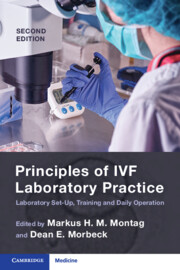Book contents
- Principles of IVF Laboratory Practice
- Principles of IVF Laboratory Practice
- Copyright page
- Contents
- Contributors
- Foreword
- The Evolution of IVF Practice
- Section 1 Starting a New Laboratory and Training Protocols
- Chapter 1 Establishing and Equipping a New IVF Laboratory
- Chapter 2 Basic Embryology Skills and Responsibilities in the IVF Laboratory
- Chapter 3 Sperm Preparation for IVF
- Chapter 4 Oocyte Pick-Up for IVF
- Chapter 5 Embryologist Training: Embryo Transfer
- Chapter 6 ICSI for IVF
- Chapter 7 Embryo Assisted Hatching for IVF
- Chapter 8 Embryo Biopsy for IVF
- Chapter 9 Vitrification for IVF
- Section 2 Pre-procedure Protocols
- Section 3 Gametes
- Section 4 Insemination/ICSI
- Section 5 Fertilization Assessment
- Section 6 Embryo Assessment: Morphology and Beyond
- Section 7 Embryo Cryopreservation
- Section 8 Embryo Transfer
- Section 9 Quality Management
- Index
- References
Chapter 1 - Establishing and Equipping a New IVF Laboratory
from Section 1 - Starting a New Laboratory and Training Protocols
Published online by Cambridge University Press: 07 August 2023
- Principles of IVF Laboratory Practice
- Principles of IVF Laboratory Practice
- Copyright page
- Contents
- Contributors
- Foreword
- The Evolution of IVF Practice
- Section 1 Starting a New Laboratory and Training Protocols
- Chapter 1 Establishing and Equipping a New IVF Laboratory
- Chapter 2 Basic Embryology Skills and Responsibilities in the IVF Laboratory
- Chapter 3 Sperm Preparation for IVF
- Chapter 4 Oocyte Pick-Up for IVF
- Chapter 5 Embryologist Training: Embryo Transfer
- Chapter 6 ICSI for IVF
- Chapter 7 Embryo Assisted Hatching for IVF
- Chapter 8 Embryo Biopsy for IVF
- Chapter 9 Vitrification for IVF
- Section 2 Pre-procedure Protocols
- Section 3 Gametes
- Section 4 Insemination/ICSI
- Section 5 Fertilization Assessment
- Section 6 Embryo Assessment: Morphology and Beyond
- Section 7 Embryo Cryopreservation
- Section 8 Embryo Transfer
- Section 9 Quality Management
- Index
- References
Summary
Attention to detail and robust quality control systems are essential components for a successful IVF laboratory, necessary to maintain high success rates. This not only pertains to daily laboratory operations, such as adequate staff training, monitoring of equipment function or weekly/monthly success rates, but also entails proper laboratory design and construction. A highly successful IVF laboratory requires careful consideration of layout and workflow and use of appropriate materials to avoid introducing potentially embryotoxic factors into the laboratory environment.
Information
- Type
- Chapter
- Information
- Principles of IVF Laboratory PracticeLaboratory Set-Up, Training and Daily Operation, pp. 1 - 8Publisher: Cambridge University PressPrint publication year: 2023
